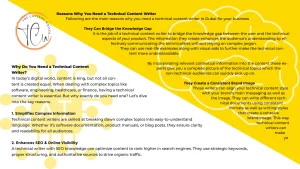Every business in 2023 needs a robust content strategy and content writing is its foundation. If you’re a business owner and you’re not leveraging content writing in your marketing efforts, you are missing out.
Ask the writers and they say content writing is an art. But unlike art, there can be mistakes here. If you just started a blog for your business, chances are, you might make mistakes while writing them, and often, you wouldn’t know what they are.
We’ve written thousands of blog posts, articles, and web content, so it’s safe to say that we have mitigated all major mistakes from our blogs.
Now, we are helping you do the same with a list of the most common mistakes in content writing and how you can easily avoid them.
Let’s begin!
Table of Contents
Content Writing Mistakes to Avoid
1. Writing for Yourself, Not for Your Audience
3. Not Planning Content Beforehand
4. Not Following a Clear Structure and Format
5. Using Tough Words and Sentences
6. Not Optimizing Your Content for Keywords
7. Avoiding Different Perspectives
8. Writing Without Giving Details
9. Ending Without a Call to Action
10. Not Proofreading and Editing Your Content
BONUS: Using AI-Generated Content
Content Writing Mistakes to Avoid
Your business may be in the services industry, e-commerce, online tutoring, or any other industry that needs a website, but writing blogs is a completely different skill with special techniques that demand experience.
It is critical that you understand how to find content writing mistakes, so that the next time you write a blog for your brand’s website, you can avoid those mistakes.
Let The Content Writer help you with that.
1. Writing for Yourself, Not for Your Audience
Sure, you know your business more than anyone. So when you’re thinking of writing blog posts on your website, your brain would be bubbling with ideas for many of your favorite topics.
These topics may be relevant to your products or services, but is your target audience interested in these topics?
People search things online for 4 main reasons:
- To solve problems
- To learn new skills
- To find information
- To be entertained
So, your company’s blog topics should at the least do any of the above. But how do you find out what problems they have, what skills they need, and what information they’re looking for?
This is where you need to first know your audience. For that, you can:
- Conduct surveys, interviews, or focus groups to get feedback from your audience and learn about their preferences, expectations, and problems.
- Use analytics tools, such as Google Analytics, to track and measure your audience’s behavior, interests, and demographics.
- Create buyer personas, which are fictional representations of your ideal audience, based on your research and data.
- Use these personas to guide your content creation and tailor your content to each persona’s needs, goals, and motivations.
2. Not Doing Enough Research
There is one thing that stands above all when it comes to business-customer relationships, and that is Trust.
For your customers to trust you, you need to give them valuable products and services that do exactly what they should do or even more, but never less.
But people become your customers when they discover your brand from the content you post online – be it blogs, your website, social media posts, or even ads. As they read your content, they need to find it believable, and trustworthy. For that, you need research – lots of it.
Read at least 10 to 20 articles from credible sources before you write about a specific topic in your industry. Also, remember to give credit to your sources. This makes your readers aware of the fact that you took the time to do your research.
3. Not Planning Content Beforehand
If you write content without having a clear idea of what you want to achieve, who you want to reach, and what you want to say, it can result in content that is unfocused, unstructured, or unappealing to your readers.
To avoid this mistake, you need to plan content beforehand.
- Use brainstorming techniques, such as SCAMPER, which stands for substitute, combine, adapt, modify, put to another use, eliminate, and reverse, to generate and refine your ideas, and to make your content more creative and original.
- Use mind maps, such as MindMeister, to brainstorm and organize your ideas, and to visualize your content flow and structure.
- Use calendars, such as Google Calendar, to schedule your content creation and publication dates, and to keep track of your deadlines and milestones.
4. Not Following a Clear Structure and Format
In this age of endless scrolling on social media, getting a few seconds of attention from your target audience is a luxury. Not to mention the addictive nature of 30-second videoclips has made people numb to reading.
So, to get people to read your brand’s blog posts, you need to make them as visually consumable as possible.
The easiest way to do that is to structure and format your content with headings (H1, H2, H3 tags), subheadings, bullet points, and numbers. You can also use Bold text to label important text and italic text to highlight examples, questions, and quotes.
Instead of doing all this after writing the content of your entire blog, you can plan ahead by creating an Outline for your blog. Creating an outline before you start writing will help you structure and format your blog and make the writing process quicker.
5. Using Tough Words and Sentences
Just like the previous point with people these days generally having lower attention spans, It’s a similar story here too. If the content you write sounds complex with difficult words and sentences that are hard to keep up, they would lose interest in less than 10 seconds.
While you want your content to sound clever, with some fun use of vocabulary, it should not make the reader feel less intelligent. The content should be simple so that they can easily understand what they read, but not so simple that it sounds worthless.
You can use tools like Hemingway Editor while writing, and after completing your blog, you can check its readability score using a tool like WebFX’s readability checker.
6. Not Optimizing Your Content for Keywords
The main goal of writing content on your website is to get more traffic. But for that, search engines like Google and Bing should be able to identify what you’re writing about.
Of course, web crawlers these days are intelligent enough to find out what a blog is about, but with almost all brands choosing to post blogs every week, it’s getting harder to stand out.
So, while writing content, you need to optimize it for keywords and search engines. You might already know this process as Search Engine Optimization (SEO).
- First, you need to understand your target audiences’ search intent
- Then develop Seed Keywords – which are short and general words or phrases with a higher search volume and competition, but very low conversion rates.
- From that, you need to find Long-Tail Keywords – which are longer and more specific words or phrases that have a lower search volume, but higher conversion rates and less competition.
- Then filter this long list and prioritize the most relevant keywords.
- Finally, from this short list, find LSI Keywords – which are words or phrases that are related to your main keyword.
Ideally, after you find all these keywords, you can think about topics surrounding these keywords, so that you can place them naturally in your blogs.
7. Avoiding Different Perspectives
Imagine watching a movie that has only one camera angle… sounds boring right? That’s exactly the case with content writing too. Your readers need information from different angles and points of view. You cannot expect them to blindly believe what you write.
Using different perspectives shows that you have considered various aspects, opinions, and arguments of your topic. Not including different perspectives will make your content biased, narrow, or incomplete.
To include different perspectives, you need to:
- Use multiple sources of information, such as books, journals, websites, or experts, to research and learn about your topic from different angles and viewpoints.
- Acknowledge different opinions, beliefs, or values that your audience or others may have about your topic, and respect and address them in your content.
- Address counterarguments, objections, or questions that your audience or others may have about your topic, and provide reasons and evidence to refute or answer them.
8. Writing Without Giving Details
Since the demise of traditional marketing techniques, brands have switched to content strategies that prioritize giving valuable information to users in the form of blogs, videos, etc.
But in the quest to get a piece of this pie, many small businesses write content just for the sake of it. Their only goal is to get traffic to their website and not to educate or inform their target audience.
This thinking has resulted in blogs that lack depth. Users get nothing out of such writing and chances are, they’ll probably never come back to those sites again.
Fortunately, Google has tackled this issue with its Helpful Content System update in 2023. With this in place, Google downranks websites with poor quality, low value, and unhelpful content.
This has forced many businesses to rethink their marketing strategy. To avoid such a thing from happening to your website, you need to give details to support your claims, arguments, and ideas. Writing without giving details will make your content vague, weak, and unconvincing.
- Use examples, anecdotes, and evidence to illustrate your points and make them more concrete and relatable.
- Use facts, statistics, and data to back up your points and make them more credible and authoritative.
- Use quotes, testimonials, and reviews to reinforce your points and make them more persuasive and trustworthy.
9. Ending Without a Call to Action
A call to action is a sentence or phrase that tells your readers what they should to do next. Ending without a call to action will make your content incomplete, ineffective, or passive.
To write a call to action, you can:
- Use clear, direct, and urgent language to tell your readers what action you want them to take, such as subscribing, contacting, or sharing.
- Use buttons, links, or incentives to make it easy and attractive for your reader to take action, such as “Subscribe Now”, “Contact Us Today”, or “Get Your Free Ebook”.
- Use benefits, solutions, or emotions to motivate your reader to take action, such as “Get 10% OFF if you Book Today”, “End your Plumbing woes now”, or “Don’t Miss This Opportunity”.
10. Not Proofreading and Editing Your Content
People lose trust in a brand that makes mistakes consistently. So, you need to be careful while creating any form of content and it holds true for content writing too.
- Check your content for spelling, grammar, punctuation, and clarity, and correct any mistakes or errors that you find.
- Check your content for style, tone, voice, and format, and ensure that they are consistent and coherent across your content.
- Check your content for readability, SEO, and performance, and improve any aspects that can enhance your content effectiveness and visibility.
BONUS: Using AI-Generated Content
With the advent of ChatGPT and other Large Language Models in 2023, many businesses have started using AI to write full-length blogs for them. They have fallen to the idea of creating content free of cost in just a few minutes.
However, if they understood how ChatGPT works, they themselves would stop using it. While ChatGPT 4 searches the internet in real-time for information, ChatGPT 3.5 has a predefined set of data up to 2021. It does not have access to recent information.
Even with current information, ChatGPT 4 has its limitations while writing content for the web. It lacks the human touch and sounds very robotic. It makes mistakes often and does not produce accurate information at times.
It is a great tool, nonetheless, but it is not a content writer. So, for writing content on your brand’s website, avoid using ChatGPT.
Final Thoughts
To sum it up, always remember to write for your user. The goal should be to give valuable content to your readers.
We hope that this blog will help you prevent any content writing mistakes in the future.
Also, we understand if all this feels overwhelming to you as a business owner, which is why you can simply automate it with help from top content writing agencies in Dubai.
We’ve been writing blogs for multiple businesses all over the world and all our clients have reported drastic increases in their revenue after signing a deal with us. That’s the power of high-quality content.
So, what are you waiting for, call The Content Writer today.




